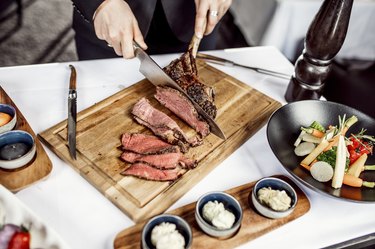Let’s know the ‘Only Type of Red Meat Heart Health To Cook’ Eating conventionally farmed animals has been stigmatized recently due to the development of plant-forward diets.
The case is typically made against eating meat and in support of a plant-based diet. Grass-fed meat is a third choice, however, it isn’t frequently discussed.
If you eat meat and your budget permits it, grass-fed meat is a wise menu option due to its health benefits. Here, medical professionals discuss the Only Type of Red Meat Heart Health To Cook and health benefits of grass-fed meat, and how to include it in your diet.
What Is Grass-Fed Meat?
Most grass-fed meat is comprised of beef, lamb, and goat.
According to the Environmental Protection Agency, conventional beef is often farmed on an industrial farm known as a Concentrated Animal Feeding Operation (CAFO). Animals at CAFOs are frequently kept in cramped quarters and given a diet of subsidized grains including corn, soy, and wheat.
The National Association of Local Boards of Health states that they might be given hormones to hasten growth together with antibiotics to treat and prevent illnesses. (Just so you know, the FDA has not approved the use of growth hormones in dairy cows, veal calves, pigs, or poultry.)
Grass-fed beef and other animals, on the other hand, are raised in a natural setting: on a pasture. In addition to red meat, the larger term “pasture-raised meat” can also refer to hens, eggs, and pigs. When an animal is reared on a pasture, it signifies that it had lots of access to the outdoors and was raised in its natural habitat. However, they might have been fed some grain or another type of feed, and they might have received antibiotics and growth hormones at any point in their lives.
When reading labels, it can be useful to understand a few key categories of beef.
- Grass-fed: According to the USDA, “grass-fed” refers to an animal that has only ever consumed grass or forage throughout its life, excluding milk taken before weaning. According to federal regulations, grass-fed livestock must forage on crops of grass, legumes, and/or cereal grains. Animals who are only fed on grass cannot consume grains and must always have access to pasture.
- Grain-fed: According to the South Dakota State University Extension, conventional beef production is a constantly evolving field with few set standards. The majority of the cows used to produce conventionally grown beef were pastured during the weaning process. For the rest of their life, they are given grains and other things.
- Certified Organic: Animal products with the Certified Organic designation have not received any antibiotics or hormones, as indicated by the label. Animals that are USDA-certified organic may be finished on either grass-fed or grain-fed diets provided the grain is entirely organic.
Only Type of Red Meat Heart Health To Cook And Why Grass-Fed Beef Is So Good for You
There are many health advantages to eating red meat in general. According to the USDA, one 4-ounce serving of cooked grass-fed ground beef has the following ingredients:
- Calories: 190
- Total fat: 11 g
- Saturated fat: 4.5 g
- Cholesterol: 69.4 mg
- Sodium: 69.4 mg
- Total carbs: 0 g
- Protein: 23 g
1. It’s Nutrient Dense
According to a review published in the Nutrition Journal in March 2010, grass-fed beef has higher levels of inflammatory-fighting antioxidants like glutathione and superoxide dismutase as well as fat-soluble vitamins like vitamins A and E.
According to the National Institutes of Health, vitamins A and E are both fat-soluble nutrients that support the health of our hormones, skin, and vision as well as our immune systems.
“Compared to grain-fed beef, grass-fed meat has a healthier omega-3 to omega-6 ratio, is higher in vitamin A and E content, and has less overall fat. Additionally, red meat provides bioactive substances like creatine for muscle strength and performance, carnitine for energy, and taurine for brain and muscle function “According to Samantha Cassetty, RD, a nutrition consultant with Beef + Lamb New Zealand.
2. It May Be Less Likely to Raise Your Cholesterol
While grass-fed beef still includes saturated fat, it differs from conventionally grown meat in terms of the kind of saturated fat.
According to a March 2010 study published in the Nutrition Journal, palmitic acid, myristic acid, and stearic acid are the three forms of saturated fat that can be found in red meat.
The first two are well recognized to raise cholesterol levels. Stearic acid, the final ingredient, has been demonstrated to have no effect on cholesterol levels.
Stearic acid levels are higher in grass-fed meat, and a small Clinical Nutrition study published in March 2021 connected stearic acid to lower levels of “bad” LDL cholesterol.
3. It’s Better for the Environment
In addition to being healthier for you, Cassetty asserts that grass-fed meat is also better for the environment.
According to a November 2022 study in the Environmental Impact Assessment Review. New Zealand’s grass-fed sheep and beef production has lowered its carbon emissions and has a smaller carbon footprint than meat from conventionally grown animals. This goal can be achieved “by farming livestock on open grassland and a grass-fed diet all day, every day.”
Another benefit of grass-fed meat is that it’s better for the animals. “For instance, the well-being of the animals depends on their ability to eat and live as they would naturally. Additionally, animals fed on grass are typically healthier and require little to no medication “Explained Cassetty.
4. It’s Better for Your Heart
According to the Mayo Clinic, beef raised on grass has a better balance of omega-3 to omega-6 fatty acids. According to a July 2021 article in Nutrients, the relationship between omega-3 to omega-6 ratios and a lower risk of heart disease has been well-documented.
Regardless of whether an animal is fed grain or grass, its omega-6 fatty acid content is essentially constant. According to a March 2010 Nutrition Journal study. It is the omega-3 fatty acids, the heart-healthy variety, that rise on a grass-fed diet.
According to Trent Orfanos, MD, ABIHM, Director of Integrative and Functional Cardiology. “Looking at grass-fed versus grain-fed beef through an integrative cardiologist’s perspective, there are quite a few distinctions.” “Because grass-fed meat has a superior ratio of omega-6 to omega-3 fatty acids, I would advise choosing grass-fed bull. While omega-3 fats are better for you to eat and lower inflammation, omega-6 fats have the potential to cause inflammation. Omega-6 levels in grass-fed and grain-fed beef are similar. Whereas omega-3 levels in grass-fed beef can be up to five times higher “Our source is Dr. Orfanos.
Additionally, in order to control cholesterol levels and lower the risk of heart disease, the American Heart Association advises eating less saturated fat and more omega-3 fatty acids. Therefore, increasing your omega-3 intake by eating grass-fed beef is a wise move to support heart health.
Grass-Fed Meat Brands to Try
You may probably find grass-fed or pasture-raised meat in your local supermarket. They now appear in Walmart, Target, Costco, and Aldi. Check out these brands if you wish to buy in bulk or get from a reliable website online:
- Teton Waters Ranch (Pre-made burgers, hot dogs, and sausages; $9.90 on Instacart)
- New Zealand Beef and Lamb (Priced per pound at Sam’s Club)
- US Wellness Meats (Starting at $7.88 for grass-fed ground beef)
- ButcherBox (Starting at $99 for 7+ pounds of custom-choice meat)
- Thousand Hills (Land to Market Verified beef, priced per pound and cut)
5 Tips for Cooking Grass-Fed Meat
- Since grass-fed meat is frequently leaner. It may become tougher if not cooked at lower temperatures for shorter periods of time.
- The majority of people concur that cooking steaks at 325 degrees Fahrenheit produce the most tender results.
- For optimum results when baking in the oven, think about lowering the customary temperature by roughly 50 degrees F.
- “You can select a less expensive cut if the cost of grass-fed meat worries you. E.g grass-fed lamb shoulder is a tasty cut at a lower price point than lamb leg. While grass-fed flank steak, also known as skirt steak, is the ideal cut for salads, fajitas, and stir-fries “Explained Cassetty.
- For a more flavorful and tender texture, marinate the meat. We adore these quick methods for preparing tri-tip steak.
Also Read: 9 Strategies And Ways To Avoid Food Poisoning




